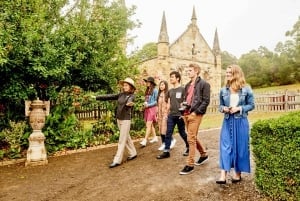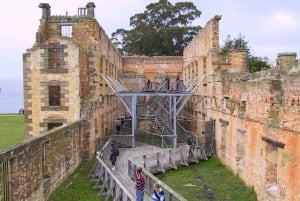Midlands
Why is it called the Midlands? After all it isn't in the middle of Tasmania. The answer lies in the past, with it being the area between two of Australia's first settlements. With Launceston established in the North and Hobart in the South, work was soon undertaken to connect the two settlements. Towns were established in between to house soldiers supervising the convict gangs that built the road and as stopovers for stagecoaches and travellers to rest or change horses. So towns in the Midlands have quite long histories and though now the Midlands Highway bypasses many of them they are well worth a visit.
The Midlands is a relatively flat and dry part of Tasmania, with the natural grasslands lending it to sheep grazing. Sheep farming continues today and with improved pastures the area is world renowned for its production of super-fine Merino wool. The Tasmanian Wool Centre in Ross houses a Heritage Museum and Wool Exhibition.
Towns in the Midlands include Campbell Town, Ross, Oatlands, Jericho, Kempton and Bagdad.
Campbell Town
Campbell Town is the only town in the midlands that the Midlands Highway still runs through making it a popular stopping place for Tasmanians, especially those travelling from the North West to Hobart. It was established in 1821 as a garrison town and probation station by the Governor of the day Lachlan Macquarie. Visit the Heritage Highway Museum housed with the Visitor Information centre. Brochures are available on heritage walks you can take around the town showing some of the fine colonial architecture. Valentine or Bicentennial Parks are good stopping places for lunch or down by the tranquil Elizabeth River. The annual Campbell Agricultural Show is held in June at the showground and is the oldest in Australia having run continuously since 1838.
Visitor Information Centre & Heritage Highway Museum: 103 High Street, Campbell Town. Telephone +61 3 6381 1353
Ross
Ross (population about 270) has been very fortunate to escape development and commercialism and retains a beautiful feel for what villages were like in the early 19th century. In fact it is probably Australia's best example of an early colonial town with many well preserved sandstone buildings, beautiful carvings on the convict-built stone bridge spanning the Macquarie River, the elm-lined main street, three magnificent old churches There are a total of 40 historic buildings in Ross with half of them located on Church Street. Pick up a map to get the most out of your visit. The town itself has been listed on the Register of the National Estate as well as many buildings individually. Ross was an important stopover as a horse coach changing point, a town for the local garrison and servicing the surrounding farms. It also was home to a female factory through which about 12 000 female convicts passed from 1848-1854. There are antique shops to visit as well as good eating establishments. The Tasmanian Wool Centre in Ross houses a Heritage Museum and Wool Exhibition and the site of the female factory has the remains of the assistant superintendent's and overseer's cottages which includes a scale model of what the site used to look like as well as other interpretive displays.
Visitor Information Centre & Tasmanian Wool Centre: Church St, Ross. Telephone: +61 3 6381 5466
Tunbridge
Tunbridge (population about 200) was originally known as Tunbridge Wells and developed as an important rest stop for coaches and travellers. Buildings of note include Tunbridge Manor in the middle of town, the Colonial Homestead (1820), the Tunbridge Wells Inn (now closed down), The Victoria Inn, the Coaching Stables (1843), The Blind Chapel and Bowerman's General Store. The Tunbridge Convict Bridge (1848) is the oldest single span bridge in Australia. It crosses the Blackman River at the northern end of town. It is a rare example of a sandstone bridge with timber decking. Nearby is a stagecoach on display. It belonged to one of the most successful coach operators named Samuel Page. He operated from Oatlands starting in the 1830s. At one time he had seven coaches and around 150 horses.
Oatlands
Oatlands (population about 760) originated as a military base for overseeing convicts who worked on public buildings, roads and bridges. It is considered to have the largest number of Georgian sandstone buildings in any town in Australia with most of them built using convict labour. The town has a total of 87 stone buildings in the Main Street and a total of 138 within the town boundaries. A copy of Let's Talk About Oatlands is invaluable to learning about the town with detailed information on 36 places of interest. The highlight for me is the Callington Mill. I remember always seeing it as a child on trips down the Midland Highway. With no sails it was just an odd round stone building that narrowed as it went up with a funny dome on the top. Just five years ago we climbed up the steep stairs on the empty inside with our children to enjoy the view from the top. Now it is just magnificent, finally restored in 2010 after a century of disuse. It is a once again a fully operational wind driven flour mill with the wind turning the white wooden sails that power the huge milling stones that grind the locally grown wheat, spelt or rye into chemical-free or organic certified flour - I love it! Guided tours are available.
Visitor Information Centre & Callington Mill Complex: 1 Mill Lane, Oatlands. Telephone +61 3 6254 1212
Jericho
Jericho (population about 50) is now a quiet town not bothering anyone. Notable buildings are the Commandant's Cottage and the Probation Station which were built in the 1940's, when Jericho had about 200 convicts working on road building with evidence still seen by convict-cut culverts, bridges and walls. In the days of the stage coach the town was a resting post.
Kempton
Kempton (population about 350) was originally known as Green Ponds but was renamed Kempton in 1840 after Anthony Kemp who appears to have been an unlikeable but influential early arrival in the district. Of interest in the town are the National Estate listed St Mary's Church of England (1844), a sandstone Gothic Revival, the Congregational Church (1840) which is a simple stone Georgian church which also has an interesting old cemetery. The Wilmot Arms Inn (1844) in the Main Road was built by convicts and operated as a licensed inn until 1897 and is now colonial accommodation. Dysart house (1842) is a large two-storey Georgian stone building (now a private residence) that is a fine example of a coaching inn.
Bagdad
Bagdad (population about 1000) was an important rest area and horse-changing place for those on the north-south journey. Interesting information on surrounding historic buildings can be found here.
Colebrook
Colebrook (population about 350) is a quiet farming settlement which was developed by convict labour as the site of a convict probation station. Of interest are the National Trust listed building The Chimneys, the former Police Station, St Patrick's Roman Catholic Church (1856) and the Old Colebrook Court House which is open daily for inspection on Saturday and Sunday from 9am - 6pm.
Photo credits: chainsaw sculpture Campbelltown, MDT; Ross historic bridge, MDT; Tunbridge Collectables, MDT; Callington Mill, Oatlands, MDT; War Memorial Clock Tower, Kempton, MDT ;St Patricks church, Colebrook, courtesy Pugin Foundation











